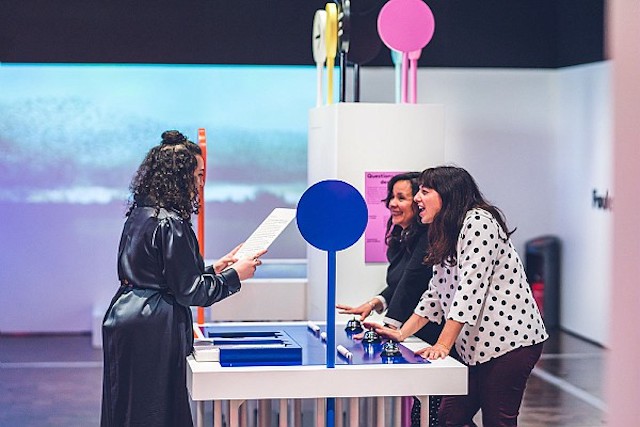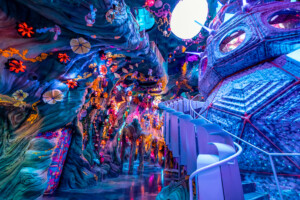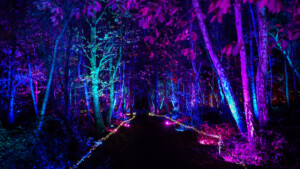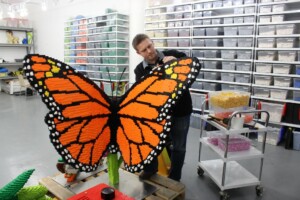Universcience, an organisation that works to make science accessible to all, has announced its latest travelling exhibition, Crowdology, the science of crowds.
What do beaches, airports, and museum exhibitions have in common? At various points throughout the day, they all find themselves chock-full of people: in other words, crowded. The new exhibition looks at questions like what causes these crowds, how can they be managed, and what similarities they have to the migration patterns of birds, amongst others.
The exhibition aims to examine a phenomenon which is universally acknowledged and experienced, yet rarely studied or understood. Co-curator Dorothée Vatinel explains that she selected the topic because of its unique position in society: “It’s the perfect subject for a science museum because it’s something everybody perceives, yet no one knows exactly what they will find when they hear the word ‘crowds.’”
Putting the visitor in the shoes of a crowd researcher
Vatinel and co-curator Astrid Aron collaborated with crowdologist Mehdi Moussaïd to create the exhibition. Moussaïd, a researcher at the Max-Planck Institute for Human Development, works to bring the study of crowds into a modern context – he shares his work through a popular YouTube channel and a book, both entitled Fouloscopie, (Crowdology).
Moussaïd’s skill in translating technical research into concepts that are easy to grasp for a wider audience was one of the reasons Vatinel and Aron wanted to work with him, they explained.
Selecting the right tone for the exhibition was a crucial aspect of the production process, as the creators realized that visitors might arrive with certain prejudices upon hearing the word ‘crowds.’ Thus, Vatinel and Aron aimed to put the visitor in the position of a researcher – or at least teach them what a crowd researcher does.
“The white color scheme throughout the exhibit evokes a clinical environment, that of a laboratory, where things are objective and removed from personal feelings,” says Vatinel.
This scenography works in tandem with the contents of the exhibition to remove stigma from the idea of a crowd. Indeed, the exhibition’s elements – from examples of scientific phenomena to an interactive virtual story to digital analysis of social networks – intend to reflect on crowds in an unbiased manner, allowing visitors to understand their benefits and consequences.
For Aron, encouraging visitors to reflect on crowds in a more positive way was of central importance to the exhibit: “It is a misconception to think that the function of a crowd is simply to foolishly follow a leader.”
Varied exhibits explore crowds and their conduct
Underlying all parts of the exhibition is the desire for visitors to own the subject themselves. Rather than presenting the visitors with information, the curators utilised a number of interactive and experiential learning elements to make visitors experts in their own right.
“When visitors learn things by themselves and the information within an exhibition speaks to them directly and is delivered in a tailored manner, they leave feeling more content with their experience,” explains Aron.
The curators define a crowd as “a number of individuals interacting in the same space.” However, nuances remain: these individuals could be humans, grains of sand, or even birds, and the space could be physical or digital. The exhibition takes care to emphasize these distinctions by using multiple methods of analysis to think about crowds.
Aron notes that Crowdology uses various subjects such as “math, physics, behavioral sciences, sociology, and history” to analyze crowds and their conduct. These are deployed across six rooms studying different themes related to crowd behavior: tightly packed crowds, pedestrians in crowds, digital crowds, rumors and their effects, bad reputations (a film exclusive to the exhibit), and through the looking glass, which offers real-time glimpses into crowdology experimentation.
Each of these rooms contains several elements supporting the central goal of the exhibition: to consider an everyday occurrence scientifically, without prejudice, and thus understand social habits and norms in a new analytical light.
For example, the exhibition contains a karaoke booth, which has multiple purposes. According to Aron, it attacks the idea of crowds as negative by reminding visitors of their advantages, such as the joy one might gain from “going to a concert and being amidst a group of people singing at the same time.” But it also has a scientific lesson: the booth demonstrates the concept that when multiple people sing together, their voices sound unified and vocally skilled, even if they are simply amateurs.
The extent of the interactive elements throughout the exhibition and its emphasis on real-world relevance and implementation both exemplifies Universcience’s goals of sharing culture through science and is a fundamental part of the study of crowds. When asked about the relevance of social interaction to the study of crowds, and if one of Crowdology’s aims is to demonstrate human desires to be with one another, Vatinel responds: “It’s exactly that.”
Earlier this year, Universcience debuted an exhibition designed to break down the walls of taboo and stigma surrounding different cancers.
Top image copyright R. Moretto


















